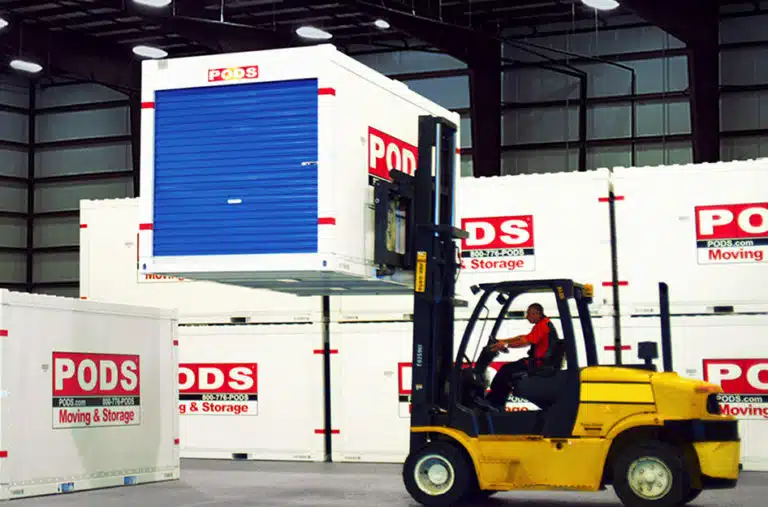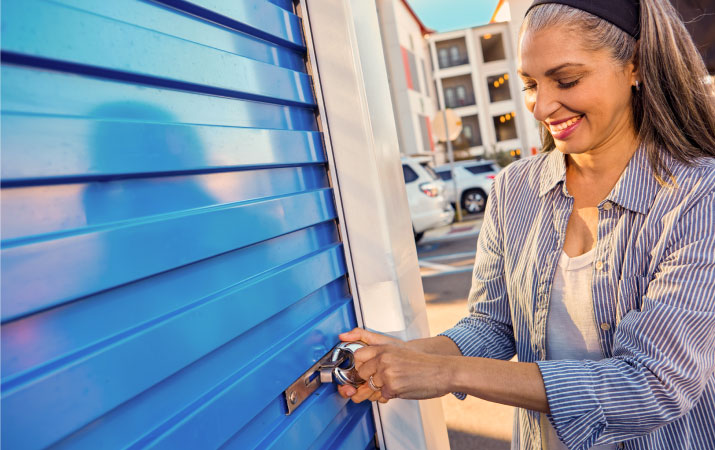
What Can I Store in a Non-Climate-Controlled Storage Container? Here’s What You Need to Consider
Storage Tips and Hacks
Whether you’re moving or simply making extra space in your home, opting to place things in storage for a little while is sometimes the best option. Packing everything up and organizing it in any old unit sounds easy enough, but there are still some decisions to be made. Not only do you have to determine what size unit is best for you, but you also need to think about whether you need a climate-controlled unit or if a non-climate-controlled one will get the job done.
Let’s take a look at both options, as well as an alternative that may actually prove to work best for your specific situation.
|
Q: Does PODS offer climate-controlled storage? While PODS’ steel-frame containers are designed to protect your items from the elements — and most things will stay safe and sound in these conditions — certain sensitive items should instead be stored in climate-controlled storage. While PODS can’t provide temperature control, their containers will work in most situations. Call 855-706-4758 to get a free quote and learn more. |
What Is Climate-Controlled Storage?
Climate-controlled storage units are exactly what they sound like. They are temperature- and humidity-controlled to protect stored belongings from temps that are too high or too low and from high humidity. The temperature in climate-controlled facilities is usually kept between 55° and 78° F, with humidity levels not exceeding 55 percent. Sounds good, but this added level of protection comes at a higher price. If your belongings don’t actually need climate-controlled storage, it makes more sense to opt for non-climate-controlled storage instead.
What Needs To Go in Climate-Controlled Storage?
There are a few things that should be kept in climate-controlled storage units over non-climate-controlled ones. Here are some examples:
What Is Non-Climate-Controlled Storage?
Non-climate-controlled storage is also exactly what it sounds like. Your items are stored in a safe, secure space, but the temperature isn’t regulated. You might turn your nose up at the thought, but in reality, it’s often more than enough to keep your items safe and sound and generally costs less than climate-controlled storage.
What Can I Store in a Non-Climate-Controlled Storage Unit?
While you’re better off storing some things in a climate-controlled unit, there’s even more that can be stored in a non-climate controlled unit. The list below is in no way complete, but it will give you an idea of the kinds of things that don’t require climate-controlled storage.

Non-climate-controlled storage is especially great for short-term moves or if you’re storing items meant to withstand extreme temperatures.
Non-Climate-Controlled Storage Tips and FAQs
Q: Does storage need to be climate-controlled?
A: No, storage doesn’t always need to be climate-controlled. Non-climate-controlled storage is especially great for short-term moves or if you’re storing items that aren’t sensitive to high temps and humidity.
Q: How do you keep your stuff safe without a temp-controlled storage unit?
A: To keep your items safe without temperature control, keep moisture control top of mind. Make sure everything is dry before you pack it away. Use sturdy boxes, avoid plastic bags, and consider using packing paper instead of bubble cushioning roll or plastic wrap. You can also use desiccants (moisture absorbers) in your storage unit to help combat humidity. These steps can help keep mold and other damaging factors away from your items.
Q: Can I store my furniture in a non-climate-controlled storage unit?
A: Whether or not you should store furniture in non-climate controlled storage really depends on the type of furniture. It’s perfectly safe as long as the piece isn’t sensitive to temperature changes and humidity. Patio furniture, for example, is built to withstand extreme conditions, and most newer furniture can withstand short-term non-climate controlled storage. If you’re hesitant, be sure to check with the furniture manufacturer first.
Q: How do you protect furniture in storage without climate control?
A: After you’ve determined that your furniture can withstand temperature and humidity changes, make sure everything is clean and dry before you store it. Then wrap everything up to ensure it’s safe before storing it off the ground on pallets or cinder blocks. Be sure not to cram too many things inside the storage unit, as well. You want to maintain some air circulation around the furniture in non-climate-controlled storage.
Q: How do you store clothes in non-climate-controlled storage?
A: Ensure your clothing is clean and dry before storing in sealed containers. Plastic bins and wardrobe boxes are great options for this. We would recommend stacking any cardboard boxes on top of plastic bins to ensure moisture from the floor doesn’t compromise the boxes.
Q: Can you store a car in a storage unit?
A: Although some storage unit providers do accommodate cars, anything that could cause a fire (like a car with gas in the tank) definitely falls under the “what not to store in non-climate-controlled storage” category.
Q: Can you store a TV in non-climate-controlled storage?
A: We don’t recommend storing a TV in a non-climate-controlled storage unit, particularly if you live in a very hot and humid climate. Extreme temperatures and humidity can damage electric connections and could cause the TV to malfunction or break.
Q: Can I store a mattress in a non-climate-controlled storage unit?
A: While it is possible to store a mattress in a non-climate-controlled storage unit, it may not be the best option if you’re storing it long-term or live in a hot and humid climate. The combination of extreme temperatures and humidity is a breeding ground for mold and mildew, not to mention the materials of the mattress itself.
Q: How do you store books in a non-climate-controlled storage?
A: When packing your books for long-term storage, be sure to wrap the books in acid-free paper to ward off mildew. Bubble cushioning roll is another good option, but stay away from plastic bags, which can actually trap moisture and damage the books over time. When the temperature changes in a non-climate controlled storage unit, the air condenses, which causes moisture to develop. Including desiccants in boxes can also help protect your books.
If you’re looking to store your priceless (or rather, extremely valuable) collection of first editions, though, you’re better off springing for climate-controlled storage or keeping them at home (or a friend’s home, for the time being).
Is Cost a Factor With Climate-Controlled Storage?
You can almost always expect climate-controlled storage to cost more than the alternative. You’re paying for peace of mind when it comes to your belongings, and that can be worth it to some, but it’s important to really weigh all the pros and cons before you decide to go for climate-controlled storage. If you don’t need it for any particular reason, then you might just end up overspending in the long run.
If you have important items, like art or family heirlooms that you have to store away, the extra expense can be worth paying for. It can also be worth it if your items are going to be in storage for a long time or you live in a very hot or humid climate.
If you don’t have any precious heirlooms in your collection, though, a PODS storage container is the perfect solution. Call 855-706-4758 to speak with a storage pro and learn about all of your options.

Heat- and humidity-sensitive items, like records and record players, should be stored in climate-controlled storage.
Do I Need Climate-Controlled Storage?
If the items you’ll be storing aren’t heat- or humidity-sensitive, then non-climate-controlled is certainly your best bet for cost-effectiveness. Want a non-climate-controlled storage unit that comes to you? Go with a portable storage container from PODS instead of a brick-and-mortar unit.
Non-Climate-Controlled Storage With PODS
Though they may not be climate-controlled, PODS’ steel-frame, portable storage containers are weather-resistant and built to protect your belongings. PODS also has secure storage facilities all over the U.S. and Canada, where you can store your container for as long as you need. Moving while your things are in storage? PODS can even transport your container to your new location.
| PODS storage centers in Canada are heated during colder months to maintain inside temperatures of 59º–68º F (15º–20º C). Thermostats are programmed to automatically heat things up once temperatures drop below this range. |
The best part? Storing with PODS is flexible. Your portable storage container is delivered right to your driveway for convenient loading. You can keep it there as long as you like or have it picked up and taken to a secure PODS storage center. When you’re ready to unload, PODS will deliver it back to your home (or wherever you need it). There’s no limit to how much you can store or how many containers you can rent. It’s almost like you call all the shots, huh?
You can visit PODS online for a free storage quote or call 855-706-4758 to speak to a PODS pro. For additional tips on storage, check out more of the PODS Blog.
Kat Piccolo is a St. Petersburg-based freelance writer whose only roommate is their cat. A member of the PODS Blog creative team, Kat loves finding ways to make moving into new spaces simple and stress-free. Between yearly apartment hopping, you can find them on the waterfront or experimenting with new ways to make coffee.
Related Articles
Comments
Leave a Comment
Your email address will not be published. Required fields are marked *
